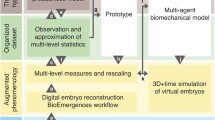Abstract
In Xenopus and Drosophila, the nucleocytoplasmic ratio controls many aspects of cell-cycle remodeling during the transitory period that leads from fast and synchronous cell divisions of early development to the slow, carefully regulated growth and divisions of somatic cells. After the fifth cleavage in sea urchin embryos, there are four populations of differently sized blastomeres, whose interdivision times are inversely related to size. The inverse relation suggests nucleocytoplasmic control of cell division during sea urchin development as well. To investigate this possibility, we developed a mathematical model based on molecular interactions underlying early embryonic cell-cycle control. Introducing the nucleocytoplasmic ratio explicitly into the molecular mechanism, we are able to reproduce many physiological features of sea urchin development.
Similar content being viewed by others
References
Agrell, I. (1956). A mitotic gradient as the cause of the early differentiation in the sea urchin embryo, in Zoological Papers in Honour of B. Hanstrom, K. G. Wingstrand (Ed.), Sweden: Lund, pp. 27–34.
Agrell, I. (1964). Natural division synchrony and mitotic gradients in metazoan tissues, in Synchrony in Cell Division and Growth, E. Zeuthen (Ed.), New York: Wiley Interscience, pp. 39–67.
Andreuccetti, P., M. R. Barone Lumaga, G. Cafiero, S. Filosa and E. Parisi (1987). Cell junctions during the early development of the sea urchin embryo Paracentrotus lividus. Cell Differ. 20, 137–146.
Andreuccetti, P., S. Filosa, A. Monroy and E. Parisi (1982). Cell-cell interactions and the role of micromeres in the control of the mitotic pattern in sea urchin embryo. Prog. Clin. Biol. Res. B85, 21–29.
Clarke, P. R., I. Hoffmann, G. Draetta and E. Karsenti (1993). Dephosphorylation of cdc25-C by a type-2A protein phosphatase: specific regulation during the cell cycle in Xenopus extracts. Mol. Biol. Cell 4, 397–411.
Dasso, M. and J. W. Newport (1990). Completion of DNA replication is monitored by a feedback system that controls the initiation of mitosis in vitro: studies in Xenopus. Cell 61, 811–823.
Edgar, B. A., C. P. Kiehle and G. Schubiger (1986). Cell cycle control by the nucleocytoplasmic ratio in early Drosophila development. Cell 44, 365–372.
Giudice, G. (1973). Developmental Biology of the Sea Urchin Embryo, New York: Academic Press.
Hagstrom, B. E. and S. Lonning (1969). Time-lapse and electron microscopic studies of sea urchin micromeres. Protoplasma 68, 271–288.
Hartley, R. S., R. E. Rempel and J. L. Maller (1996). In vivo regulation of the early embryonic cell cycle in Xenopus. Dev. Biol. 173, 408–419.
Horstadius, S. (1973). Experimental Embryology of Echinoderms, Oxford: Clarendon Press.
King, W. R., R. J. Deshaies, J. Peters and M. W. Kirschner (1996). How proteolysis drives the cell cycle. Science 274, 1652–1659.
Kominami, T. and M. Takaichi (1998). Unequal division at the third cleavage increase the number of primary mesenchyme cells in sea urchin embryos. Dev. Growth Differ. 40, 545–553.
Kumagai, A., Z. Guo, K. H. Emami, S. X. Wang and W. G. Dunphy (1998). The Xenopus Chk1 protein kinase mediates a caffeine-sensitive pathway of checkpoint control in cell-free extracts. J. Cell Biol. 142, 1559–1569.
Marlovits, G., C. J. Tyson, B. Novak and J. J. Tyson (1998). Modeling M-phase control in Xenopus oocyte extracts: the surveillance mechanism of unreplicated DNA. Biophys. Chem. 72, 169–184.
Mastro, A. M. and A. D. Keith (1984). Diffusion in the aqueous compartment. J. Cell Biol. 99, 180s–187s.
Masuda, M. (1979). Species specific pattern of ciliogenesis in developing sea urchin embryos. Dev. Growth Differ. 21, 545–552.
Masuda, M. and H. Sato (1984). Asynchronization of cell division is concurrently related with ciliogenesis in sea urchin blastulae. Dev. Growth Differ. 26, 281–294.
Murray, A. and T. Hunt (1993). The Cell Cycle, An Introduction, New York: Freeman.
Nemer, M. and E. W. Stuebing (1996). Wee1-like Cdk tyrosine kinase mRNA level is regulated temporally and spatially in sea urchin embryos. Mech. Dev. 58, 75–88.
Newport, J. and M. Kirschner (1982a). A major developmental transition in early Xenopus embryos: I. Characterization and timing of cellular changes at the midblastula stage. Cell 30, 675–686.
Newport, J. and M. Kirschner (1982b). A major developmental transition in early Xenopus embryos: II. Control of the onset of transcription. Cell 30, 687–696.
Novak, B. and J. J. Tyson (1993). Numerical analysis of a comprehensive model of M-phase control in Xenopus oocyte extracts and intact embryos. J. Cell Sci. 106, 1153–1168.
O’Connell, M. J., J. M. Raleigh, H. M. Verkade and P. Nurse (1997). Chk1 is a wee1 kinase in the G2 DNA damage checkpoint inhibiting cdc2 by Y15 phosphorylation. EMBO J. 16, 545–554.
Parisi, E., S. Filosa, B. De Petrocellis and A. Monroy (1978). The pattern of cell division in the early development of the sea urchin Paracentrotus lividus. Dev. Biol. 65, 38–49.
Parisi, E., S. Filosa and A. Monroy (1979). Actinomycin D—disruption of the mitotic gradient in the cleavage stages of the sea urchin embryo. Dev. Biol. 72, 167–174.
Parisi, E., S. Filosa and A. Monroy (1981). Spatial-temporal coordination of mitotic activity in developing sea urchin embryos, in Chaos and Order in Nature, H. Haken (Ed.), Berlin: Springer-Verlag, pp. 208–215.
Smythe, J. W. and J. Newport (1992). Coupling of mitosis to the completion of S phase in Xenopus occurs via modulation of the tyrosine kinase that phosphorylates p34cdc2. Cell 68, 787–797.
Yasuda, G. K., J. Baker and G. Schubiger (1991). Temporal regulation of gene expression in the blastoderm Drosophila embryo. Genes Dev. 5, 1800–1812.
Yasuda, G. K. and G. Schubiger (1992). Temporal regulation in the early embryo: is MBT too good to be true? Trends Genet. 8, 124–126.
Zubay, G. (1983). Biochemistry, Reading, MA: Addison-Wesley, pp. 59.
Author information
Authors and Affiliations
Corresponding author
Rights and permissions
About this article
Cite this article
Ciliberto, A., Tyson, J.J. Mathematical model for early development of the sea urchin embryo. Bull. Math. Biol. 62, 37–59 (2000). https://doi.org/10.1006/bulm.1999.0129
Received:
Accepted:
Issue Date:
DOI: https://doi.org/10.1006/bulm.1999.0129




